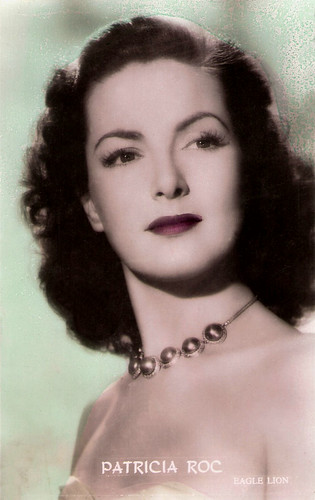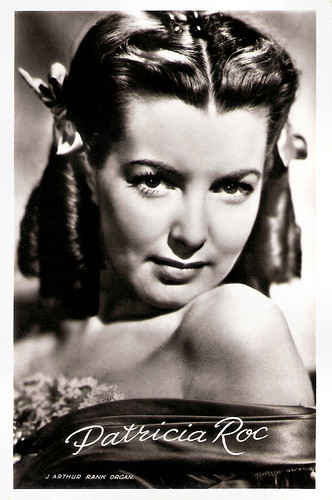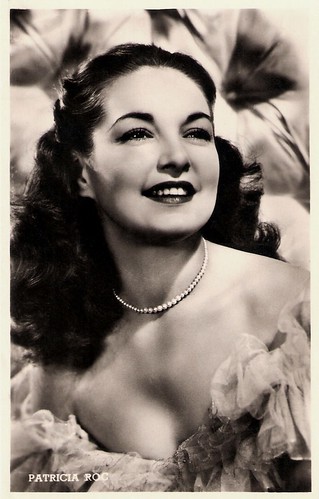British postcard. Photo: J.A. Rank Org.
British postcard in the Picturegoer series, London, no. 1122. Photo: Omnia Films.
British postcard. Photo: Gainsborough.

Vintage postcard. Photo: Eagle Lion.
Lady in Distress
Patricia Roc was born Felicia Miriam Ursula Herold in London in 1915. She was the adoptive daughter of a Dutch-Belgian father, André Riese, a wealthy stockbroker, and a half-French mother. She had two sisters called Marie-Louise and Barbara. ‘Pat’ did not learn that she was adopted as a baby until she was 34 when she needed her birth certificate in order to marry her second, French husband.
Roc was educated at private schools in London, followed by a finishing education in Paris. In 1937 she joined London's Royal Academy of Dramatic Arts (RADA). A year later she started as a stage actress, debuting in a Guy Bolton revue, Nuts And May (1938).
She was seen in this production by film mogul Alexander Korda who cast her in a minor role in the romantic comedy The Divorce of Lady X (Tim Whelan, 1938) starring Merle Oberon and Laurence Olivier.
Korda then offered her a leading role as the Polish Princess in the costume epic The Rebel Son (Adrian Brunel, Albert de Courville, Alexis Granowsky, 1938). This was an English-language version of the French film Tarass Boulba (Alexis Granowsky, 1936) starring Harry Baur, utilising much of the action footage from the earlier film.
She learned the trade in a few B-films as a 'lady in distress', including the Edgar Wallace thrillers The Gaunt Stranger (Walter Forde, 1938) and The Mind Of Mr Reeder (Jack Raymond, 1939).
Roc came into her own in patriotic films backing the war effort. She helped Alastair Sim fight the closing of a village hall in Let The People Sing (John Baxter, 1941) based on a novel by J.B. Priestley, and she supported Vera Lynn, the 'Forces' Sweetheart', in We'll Meet Again (Philip Brandon, 1942), a story loosely based on Lynn’s rise to radio fame.
British postcard.

Dutch postcard.

Dutch postcard by Uitgeverij Takken, Utrecht, no. 3105.

Dutch postcard, no. 3238. Photo: J. Arthur Rank Org.
Demure Lower-middle-class Girl
In 1943 Patricia Roc became one of Britain's 10 box-office stars for 10 consecutive years, surpassed only by Margaret Lockwood. In the Gainsborough production Millions Like Us (Sidney Gilliat, Frank Launder, 1943), she played the demure lower-middle-class girl who is called up for war service and is directed into a factory making aircraft parts. She marries a young airman (Gordon Jackson) but he is killed in action.
The Rank Organization (with the distinctive logo of the Gongman) contracted her. Rank was the largest and most vertically-integrated film company in Britain, owning distribution, exhibition and production facilities (including the Gainsborough Studios). The head of the studio, J. Arthur Rank described Roc as ‘the archetypal British beauty, the Goddess of Odeon's’.
'Pat' co-starred with Phyllis Calvert, Jean Kent and Flora Robson as internment camp inmates in Two Thousand Women (Frank Launder, 1944), who secretly assist the underground.
She then achieved her greatest level of popularity in a series of escapist melodramas for Gainsborough. In these films Roc usually represented the stereotype of the sweet young thing, menaced by ‘bad girls’ like Jean Kent or Margaret Lockwood, or by rakes like James Mason or Stewart Granger.
Love Story (Leslie Arliss, 1944) allowed her to play a concert pianist ánd Margaret Lockwood's jealous rival for Stewart Granger's love. In one scene they had to slap each other's faces, but she later commented that she and Lockwood remained always the best of friends.
They again played rivals in the costume dramas The Wicked Lady (Leslie Arliss, 1945) and Jassy (Bernard Knowles, 1947). The most famous of these films is The Wicked Lady, the top box-office draw of 1946 in the UK. Roc is back in the ‘nice girl’ role and has her fiancé stolen from her by Lockwood, her best friend. Lockwood does the 'dirty' on Roc again in Jassy by pinching Dermot Walsh from her.
Another huge success was the melodrama Madonna of the Seven Moons (Arthur Crabtree, 1945) in which she played the daughter of Phyllis Calvert (although the two actresses differed only four months in age). The films were loathed by critics and loved by the public.
Roc's more overt sexuality in these films was downplayed for the American market. Her - and Lockwood’s - cleavage led US censors to call for retakes to de-emphasise it.
In the US Roc made only one film, Walter Wanger's production Canyon Passage (Jacques Tourneur, 1946). In this offbeat Western she again loses the hero (Dana Andrews) to the bigger star (Susan Hayward). This brief move to Hollywood was a loan-out arrangement between Rank and Universal Studios of British in return for American film actors.
During filming, Roc was romantically linked with Ronald Reagan. The following year the romance resumed when Reagan came to Great Britain to make The Hasty Heart (Vincent Sherman, 1949).
Roc played a tempestuous orphan girl in a Scottish fishing village in her next film, The Brothers (David MacDonald, 1947). The orphan has her pick of men, causing rivalry, murder, suicide and ritual killing in the highly superstitious community. The grim tale was not popular at the time but has since gained in reputation.

Dutch postcard by J.S.A. Photo: Universal M.P.E.
British postcard.
Norvegian postcard by Enerett K. Harstad, Kunstforlag, Oslo, no. 57. Photo: Rank.
British postcard in the A Real Photograph series, no. F. S. 38. Patricia Roc with pet Peke 'Floppy' welcome some of the 25,000 guests at the Sunday Pictorial Film Garden Party.
The Goddess of the Odeons
Patricia Roc’s career reached another peak in 1948 with When The Bough Breaks (Lawrence Huntington, 1948), an adoption drama that mirrored her own life, and with the musical One Night With You (Terence Young), 1948. During the shooting of the latter film film she met and fell in love with the French director of photography André Thomas, who was to become her second husband.
Roc was married three times. In 1939 - two weeks after the start of the war, the 24-year-old actress had married for the first time, to the 44-year-old Canadian osteopath Dr. Murray Laing. The union swiftly foundered, and they divorced in 1944. In 1949 she married André Thomas, and they moved to Paris.
Roc's contract with Rank had ended and she started to work in France. Her French films included the anthology Retour à la vie/Return to Life (Georges Lampin, André Cayatte, Henri-Georges Clouzot, Jean Dréville, 1949), and the Georges Simenon adaptation L'homme de la tour Eiffel/The Man on the Eiffel Tower (Burgess Meredith, 1949) starring Charles Laughton as inspector Jules Maigret.
Thomas was unable to have children, which Roc wanted. She had an affair with her co-star Anthony Steel during the filming of Something Money Can't Buy (Pat Jackson, 1952). And in 1952 Roc gave birth to a son Michael as a result of the affair. Thomas agreed to raise Michael as his own and Michael was not told the truth about his father's identity until he was in his mid-40s.
Roc appeared in the Italian films La mia vita è tua/My Life is Yours (Giuseppe Masini, 1953), Le avventure di Cartouche/Cartouche (Steve Sekely, Gianni Vernuccio, 1954) opposite Richard Baseheart, and the woman's film La vedova X/The Widow (Lewis Milestone, 1955).
After the death of Thomas, Roc returned to England in 1957. She appeared in only 3 more films including Bluebeard's Ten Honeymoons (W. Lee Wilder, 1960) in which she played one of the rich victims, thrown off a railway bridge by George Sanders. She also made a few television appearances such as the first episode of The Saint (1962) with Roger Moore as Simon Templar.
She married a third and final time, to businessman Walter Reif, in 1964, and retired from acting. Known as Felicia Reif, Patricia Roc was all but forgotten until she hit the headlines again in 1975 when she was fined £25 for shoplifting from Marks & Spencer in Oxford Street. She later stated that it was purely absent-mindedness, but she pleaded guilty in the hope of avoiding publicity.
The following year, she and her husband moved to a house overlooking the Lago Maggiore in Locarno, Switzerland. There she died in 2003 of kidney failure, aged 88. Recently a biography of Patricia Roc was published, Patricia Roc: The Goddess of the Odeons (2010) by Michael Hodgson.
Excerpt from Millions Like Us (1943). Source: Takethetube9010 (YouTube).
Trailer of The Wicked Lady (1945). Source: Littleshoemaker (YouTube).
Scene from Holiday Camp (1947). Source: Feverpitch96 (YouTube).
Sources: Ronald Bergan (The Guardian), Henry Jaremko (The Wicked Lady), Tom Vallance (The Independent), Tony Williams (Encyclopedia of British Film), BBC News, Wikipedia and IMDb.
No comments:
Post a Comment